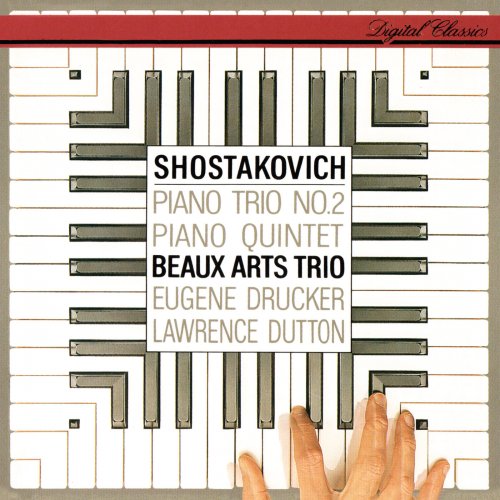
Beaux Arts Trio, Eugene Drucker, Lawrence Dutton - Shostakovich: Piano Quintet, Piano Trio No. 2 (1991)
BAND/ARTIST: Beaux Arts Trio, Eugene Drucker, Lawrence Dutton
- Title: Shostakovich: Piano Quintet, Piano Trio No. 2
- Year Of Release: 1991
- Label: Philips
- Genre: Classical
- Quality: FLAC (tracks) / MP3 320 Kbps
- Total Time: 57:22
- Total Size: 263 Mb / 149 Mb
- WebSite: Album Preview
Tracklist:
Piano Quintet in G minor, Op.57 (Dimitri Chostakovitch)
1. 1. Prelude (Lento - Poco piu mosso - lento)Beaux Arts Trio 04:15
2. 2. Fugue (Adagio)Menahem Pressler 09:49
3. 3. Scherzo (Allegretto)Beaux Arts Trio 03:31
4. 4. Intermezzo (Lento - Appassionato)Beaux Arts Trio 06:34
5. 5. Finale (Allegretto)Beaux Arts Trio 07:26
Piano Trio No.2, Op.67 (Dimitri Chostakovitch)
6. 1. Andante - Moderato - Poco più mossoBeaux Arts Trio 07:35
7. 2. Allegro con brioMenahem Pressler 02:53
8. 3. LargoBeaux Arts Trio 05:28
9. 4. Allegretto - AdagioBeaux Arts Trio 09:54
Performers:
Beaux Arts Trio
Isidore Cohen (violin)
Menahem Pressler (piano)
Peter Wiley (cello)
Lawrence Dutton (viola)
Eugene Drucker (violin)
Piano Quintet in G minor, Op.57 (Dimitri Chostakovitch)
1. 1. Prelude (Lento - Poco piu mosso - lento)Beaux Arts Trio 04:15
2. 2. Fugue (Adagio)Menahem Pressler 09:49
3. 3. Scherzo (Allegretto)Beaux Arts Trio 03:31
4. 4. Intermezzo (Lento - Appassionato)Beaux Arts Trio 06:34
5. 5. Finale (Allegretto)Beaux Arts Trio 07:26
Piano Trio No.2, Op.67 (Dimitri Chostakovitch)
6. 1. Andante - Moderato - Poco più mossoBeaux Arts Trio 07:35
7. 2. Allegro con brioMenahem Pressler 02:53
8. 3. LargoBeaux Arts Trio 05:28
9. 4. Allegretto - AdagioBeaux Arts Trio 09:54
Performers:
Beaux Arts Trio
Isidore Cohen (violin)
Menahem Pressler (piano)
Peter Wiley (cello)
Lawrence Dutton (viola)
Eugene Drucker (violin)
There's a sardonic folksiness to much of the music of Dmitri Shostakovich (1906-1975), especially to his "chamber" works. An acerbic innocence. Musicologists and biographers have generally supposed that the works of intimate scale were composed "for the desk drawer" - hermetic works in which Shostakovich could indulge his "formalism" without fear of denunciation since most of them would not soon be performed in public. Meanwhile his symphonies, his ballets, and especially his film scores were his "proletarian" cover. I don't think I buy that. Shostakovich's music seems remarkably of a piece to me in musical idiom and affect; it's not all equal in complexity and potency but it all springs from Shostakovich's two sources: his deep Russian identity and his saturation with musical Romanticism. No composer's music, not Tchaikowsky's nor even Prokofiev's, sounds more "Russian" to me. Babushka dances with Beelzebub. Pirozhky or pelmeni chased by ice cold vodka.
Once upon a time, "chamber" music was the province of highly skilled amateurs, people who could savor the sweetest pleasure of music actively or passively, by listening or by playing it themselves. Shostakovich's chamber works are not inaccessible to the skilled amateur but they are intrinsically "public chamber" works, not chamber-sized in musical conception or in emotional color. The mere dynamics are too grand for domesticity; the second piano trio begins with an almost subliminal pianissimo on the cello but builds to a crashing fortissimo that is sustained through most of the four movements. It's too showy for anyone's "living room." It demands the full dynamics of a Steinway or Bosendorfer, and therefore the technical virtuosity of a "modern" string instrument to hold its own in such an uproar. No modest cellist or violinist need apply.
Modest, timid, withheld timbres were never the style of the Beaux Arts Trio. Held together for more than 50 years, from 1955 to 2008, by pianist Menachem Pressler, they were robustly Romantic in affect while remaining staunchly conservative in matters of technique. They always interpreted; they seldom over-interpreted. They became the "standard brand" of piano-centered chamber ensembles. There are half a dozen recordings of these two works available, attesting to their popularity. I can't declare that this is the best of them, though I prefer it to the recording by Martha Argerich and friends. The acoustic quality of this CD is excellent.
Once upon a time, "chamber" music was the province of highly skilled amateurs, people who could savor the sweetest pleasure of music actively or passively, by listening or by playing it themselves. Shostakovich's chamber works are not inaccessible to the skilled amateur but they are intrinsically "public chamber" works, not chamber-sized in musical conception or in emotional color. The mere dynamics are too grand for domesticity; the second piano trio begins with an almost subliminal pianissimo on the cello but builds to a crashing fortissimo that is sustained through most of the four movements. It's too showy for anyone's "living room." It demands the full dynamics of a Steinway or Bosendorfer, and therefore the technical virtuosity of a "modern" string instrument to hold its own in such an uproar. No modest cellist or violinist need apply.
Modest, timid, withheld timbres were never the style of the Beaux Arts Trio. Held together for more than 50 years, from 1955 to 2008, by pianist Menachem Pressler, they were robustly Romantic in affect while remaining staunchly conservative in matters of technique. They always interpreted; they seldom over-interpreted. They became the "standard brand" of piano-centered chamber ensembles. There are half a dozen recordings of these two works available, attesting to their popularity. I can't declare that this is the best of them, though I prefer it to the recording by Martha Argerich and friends. The acoustic quality of this CD is excellent.
Classical | FLAC / APE | Mp3
As a ISRA.CLOUD's PREMIUM member you will have the following benefits:
- Unlimited high speed downloads
- Download directly without waiting time
- Unlimited parallel downloads
- Support for download accelerators
- No advertising
- Resume broken downloads


